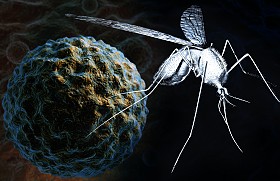 According to the Centers for Disease Control and Prevention (CDC), the recent outbreak of West Nile virus in the United States has been the largest ever reported. Nearly 2,000 cases and 87 fatalities have been reported in 2012, as of early September. Of these cases, 54% have been classified as neuroinvasive and approximately 45% have been reported from Texas. West Nile virus, which was first documented in the United States in 1999, is most often spread to humans through mosquito bites, after the mosquitos have been infected by feeding on infected birds. There is no specific treatment for infection, and most cases are either entirely asymptomatic or resolve on their own. However, about one in 150 people infected with the virus will develop severe illness, with the potential for permanent neurological damage. Since West Nile virus can also be transmitted via transfusion, the AABB recommends blood centers convert from minipool nucleic acid testing (MP-NAT) to the more sensitive individual donation nucleic acid testing (ID-NAT) during periods of West Nile virus activity. Officials from the CDC have noted that although the causes for the outbreak have been unclear, they may be linked to unusually warm weather.
According to the Centers for Disease Control and Prevention (CDC), the recent outbreak of West Nile virus in the United States has been the largest ever reported. Nearly 2,000 cases and 87 fatalities have been reported in 2012, as of early September. Of these cases, 54% have been classified as neuroinvasive and approximately 45% have been reported from Texas. West Nile virus, which was first documented in the United States in 1999, is most often spread to humans through mosquito bites, after the mosquitos have been infected by feeding on infected birds. There is no specific treatment for infection, and most cases are either entirely asymptomatic or resolve on their own. However, about one in 150 people infected with the virus will develop severe illness, with the potential for permanent neurological damage. Since West Nile virus can also be transmitted via transfusion, the AABB recommends blood centers convert from minipool nucleic acid testing (MP-NAT) to the more sensitive individual donation nucleic acid testing (ID-NAT) during periods of West Nile virus activity. Officials from the CDC have noted that although the causes for the outbreak have been unclear, they may be linked to unusually warm weather.
References
1. Department of Health and Human Services. Centers for Disease Control and Prevention. Division of Vector-Borne Diseases. West Nile Virus. Atlanta, Georgia, August 30, 2012. http://www.cdc.gov/ncidod/dvbid/westnile/wnv_factSheet.htm Accessed September 6, 2012.
2. Department of Health and Human Services. Centers for Disease Control and Prevention. Division of Vector-Borne Diseases. West Nile Virus. Atlanta, Georgia September 4, 2012. http://www.cdc.gov/ncidod/dvbid/westnile/index.htm Accessed September 6, 2012.
3. Connor J, Lipton K. AABB Association Bulletin #08-03: West Nile Virus – Revised Recommendations for Triggering Individual Donation Nucleic Acid Testing and Use of Communication Plans April 18, 2008. http://www.aabb.org/resources/publications/bulletins/Documents/ab08-03.pdf Accessed September 7, 2012.
